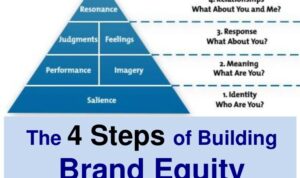Building a Corporate Brand sets the stage for success in the competitive business world, highlighting the key elements and strategies needed to create a powerful brand identity that resonates with customers.
Importance of Building a Corporate Brand
Building a strong corporate brand is essential for a company’s success as it helps establish trust and credibility with customers. A well-defined brand can set a company apart from competitors, create customer loyalty, and drive business growth.
Examples of Successful Companies with Strong Corporate Branding
- Apple: Known for its innovative products and sleek design, Apple has built a strong brand that resonates with consumers worldwide. Their brand loyalty is evident in the long lines outside stores whenever a new product is launched.
- Nike: With its iconic swoosh logo and powerful “Just Do It” slogan, Nike has successfully positioned itself as a leading athletic brand. Their branding efforts have helped them become a dominant force in the sports industry.
- Coca-Cola: Coca-Cola’s timeless logo and memorable advertising campaigns have made it one of the most recognized brands globally. The company’s branding has played a significant role in its success and longevity.
How a Corporate Brand Differentiates a Company from Competitors
A strong corporate brand helps a company stand out in a crowded marketplace by communicating its unique value proposition to consumers. By establishing a distinct identity and voice, a company can attract the right target audience and build lasting relationships with customers. This differentiation is crucial for driving customer loyalty and achieving sustainable growth in the competitive business landscape.
Elements of Corporate Branding
Building a strong corporate brand involves several key elements that work together to create a cohesive identity for a company. These elements include the logo, colors, messaging, tone of voice, and overall visual identity. Consistency across these elements is crucial in establishing a recognizable brand that resonates with customers and builds trust over time.
Logo, Building a Corporate Brand
The logo is often the most recognizable element of a corporate brand. It serves as a visual representation of the company and should be unique, memorable, and reflective of the brand’s values and personality.
Colors
The color scheme used in branding plays a significant role in conveying emotions and creating associations with the brand. Consistent use of colors across all brand materials helps in reinforcing brand recognition and building a strong visual identity.
Messaging
The messaging of a corporate brand includes the tagline, brand promise, and overall communication strategy. It is essential to maintain a consistent tone of voice and messaging across all channels to ensure that the brand’s values and personality are effectively communicated to the target audience.
Brand Storytelling
Brand storytelling is a powerful tool in creating a compelling corporate brand. By sharing authentic and engaging stories about the company’s history, values, and impact, brands can connect with customers on a deeper level and build emotional connections that foster loyalty and trust.
Strategies for Building a Corporate Brand

Building a strong corporate brand requires effective communication of the brand’s values and mission to resonate with the target audience. Understanding the target audience is crucial in shaping the brand’s image and messaging. Here are some strategies to consider:
Communicating Brand Values and Mission
- Consistent Messaging: Ensure that the brand’s values and mission are communicated consistently across all touchpoints, including marketing materials, social media, and customer interactions.
- Storytelling: Use storytelling to create an emotional connection with the audience, highlighting how the brand’s values and mission impact customers and society.
- Employee Advocacy: Empower employees to embody the brand’s values and mission, as they are often the face of the company in customer interactions.
Understanding the Target Audience
- Market Research: Conduct thorough market research to understand the demographics, preferences, and behaviors of the target audience to tailor the brand messaging accordingly.
- Persona Development: Create buyer personas to represent different segments of the target audience, helping to personalize communication and offerings.
- Feedback Mechanisms: Implement feedback mechanisms to gather insights from customers and adjust branding strategies based on their preferences and feedback.
Creating a Memorable Brand Experience
- Brand Consistency: Ensure a consistent brand experience across all touchpoints, from the website to physical stores, to create a cohesive and memorable brand image.
- Emotional Connection: Foster an emotional connection with customers through personalized experiences, exceptional customer service, and meaningful interactions.
- Innovative Branding: Explore innovative branding strategies, such as experiential marketing or interactive content, to create unique and memorable brand experiences.
Managing and Maintaining a Corporate Brand

In the competitive business landscape, managing and maintaining a corporate brand is crucial to ensure long-term success and sustainability. This involves actively monitoring the brand’s reputation, overcoming challenges in maintaining consistency across various channels, and leveraging employee advocacy to uphold and promote the brand.
Significance of Brand Monitoring and Reputation Management
Effective brand monitoring and reputation management are essential in maintaining a positive corporate brand image. By actively monitoring social media, news outlets, and customer feedback, companies can quickly address any negative publicity or issues that may arise. This proactive approach helps in safeguarding the brand’s reputation and ensuring trust and credibility among stakeholders.
- Regularly monitoring online mentions, reviews, and comments helps in identifying potential PR crises and addressing them promptly.
- Implementing strategies to manage and respond to customer feedback can enhance brand perception and loyalty.
- Utilizing tools and analytics to track brand sentiment and performance provides valuable insights for continuous improvement.
Challenges in Preserving a Consistent Brand Image
Maintaining a consistent brand image across different channels poses significant challenges for companies. With the proliferation of digital platforms and communication channels, ensuring brand coherence and messaging alignment can be complex.
Adapting brand messaging to suit diverse audiences and platforms without diluting the core brand identity is a delicate balancing act.
- Coordinating marketing efforts across offline and online channels while maintaining brand integrity requires a cohesive strategy.
- Managing multiple touchpoints and interactions with customers demands a unified brand voice and experience.
- Addressing cultural and regional differences in brand perception calls for localized strategies and communication approaches.
Role of Employee Advocacy
Employee advocacy plays a crucial role in upholding and promoting the corporate brand. Engaged and empowered employees can serve as brand ambassadors, amplifying the brand message and values both internally and externally.
- Encouraging employees to share their positive experiences and insights about the brand can enhance credibility and authenticity.
- Training and equipping employees with the necessary tools and knowledge to represent the brand effectively fosters a culture of brand advocacy.
- Involving employees in brand-building activities and initiatives instills a sense of ownership and pride in the brand, leading to increased brand loyalty and advocacy.





